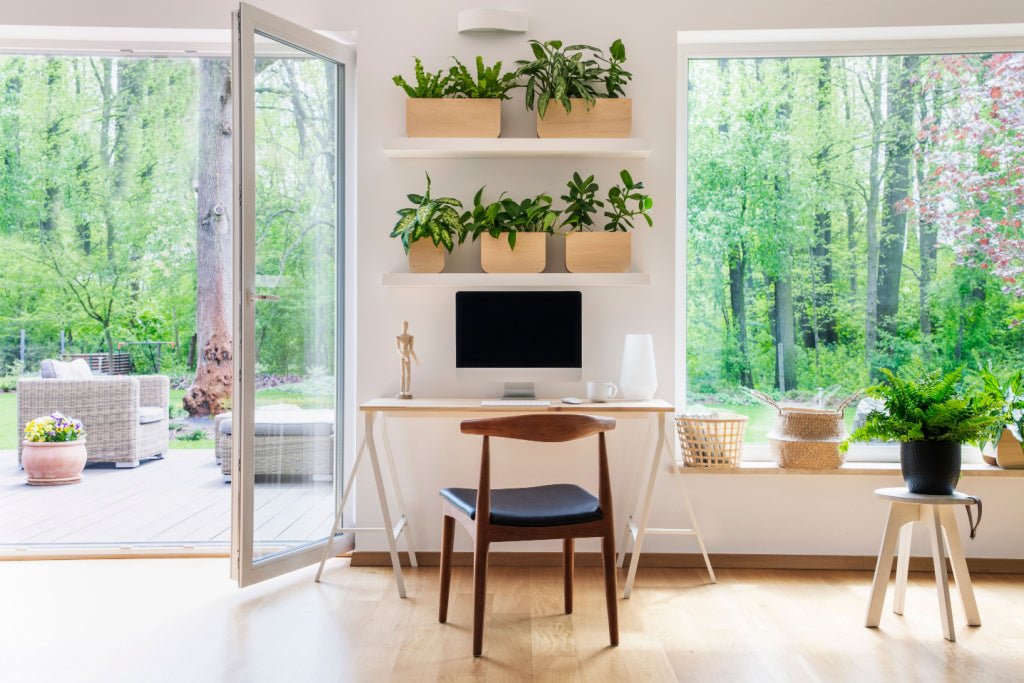
Natural lighting refers to the lighting that is generated naturally with the help of natural sources such as the sun or the stars. The technique of natural lighting harnessing requires strategic use of natural light to be let into your home with the help of careful architectural designs such as windows or skylights. Unlike artificial lighting, natural lighting is free and hence reduces energy requirements significantly. It has also been proven to increase health and comfort levels. Before modern lamps were discovered, architects relied heavily on the Sun and its positions by designing large windows or designing the house orientation according to the sun’s changing positions throughout the day. In recent years, most architects are once again advocating for a balanced way of accommodating natural sunlight in house designs to save money as well as stay healthy.
What are the Principles of Natural Lighting?
While the idea of natural lighting may seem as simple as using the sources to light up your indoors, it in fact is a little more complicated. For example, letting sunlight in is crucial but how much sunlight should be let in? Sun is not only a source of light but it also gives off a lot of heat and glare which may cause discomfort when received in larger amounts. Therefore, it is crucial that the natural light used is not only effective but also well-balanced. This brings us to the various principles that determine how we use natural lighting when designing our homes.
The sun is not stationary. It keeps changing its position throughout the day, a fact that needs to be kept in mind to best apply natural lighting, so that they properly integrate with your home lighting design. The major principles of natural lighting are therefore to use the lighting phases, maximise lighting and manipulate lighting in a way that you get a controlled as well as efficient admission of natural light.
How Natural Lighting Should Be?
Due to its countless benefits, natural lighting has been quite a popular concept recently. However, it is worth noting that natural lighting is not without its shortcomings. There are certain very important factors that should be taken into account when designing the lighting requirements of your house. Most people do not understand that daylighting requires more than just building windows and skylights. For effective use of daylighting, it is crucial that the use is strategic and controlled. Because the sun is such a powerful source of natural light, it can also produce a tremendous amount of heat making it uncomfortably hot for you during the summer days. Therefore, if not planned carefully, using natural lighting can result in undesirable heat gains. Strategic placement of windows or wall openings is also important to ensure that the daylighting can properly illuminate the space as many times, as architectural obstructions such as the roof or the building angles can prevent the daylight from entering and lighting up your space. Arrangements should also be made so that the daylight received is not very harsh on the eyes as it may cause strains. It should be ample but also warm on the eyes.
What are Natural Lighting Sources?
Natural lighting sources refer to any light provided by the sun or other celestial bodies, without the intervention of human-made sources. These sources are crucial for life on Earth, influencing ecosystems, human health, and the environment. Here are the primary natural lighting sources:
Sunlight: The most significant and abundant source of natural light, sunlight is essential for the well-being of all living organisms. It facilitates photosynthesis in plants, helps regulate biological clocks in humans and animals, and provides warmth and energy to the Earth.
Moonlight: Reflected sunlight from the moon's surface provides moonlight, a softer, less intense source of light at night. While not as bright or warm as sunlight, moonlight influences animal behavior and ecosystems, especially in nocturnal species.
Starlight: Light emitted from stars other than our sun reaches the Earth, contributing to the natural light available in the night sky. Although much less intense than sunlight, starlight has fascinated humans for millennia, aiding in navigation and inspiring cultural and scientific endeavors.
Lightning: During thunderstorms, lightning provides intense, brief flashes of light. This natural electrical discharge illuminates the sky and the surrounding area, showcasing the power of nature.
Bioluminescence: Certain organisms, such as fireflies, some fungi, and marine life like jellyfish, possess the ability to produce light through chemical reactions within their bodies. This light can illuminate their surroundings in unique ways and is used for communication, attraction, and predation.
Auroras: Natural light displays in the Earth's sky, typically seen in high-latitude regions (around the Arctic and Antarctic). Auroras are caused by the interaction between the Earth's magnetic field and charged particles from the sun. They create stunning visual effects in various colors, most commonly green, pink, and purple.
Why is Natural Lighting Important?
Natural light is important for a multitude of reasons, spanning environmental, health, psychological, and economic domains. Its significance is deeply rooted in both our biological systems and environmental interactions. Here are some key reasons why natural lighting is crucial:
1. Health Benefits:
Vitamin D Synthesis: Exposure to sunlight helps the human body synthesize Vitamin D, which is essential for bone health, immune function, and reducing the risk of chronic diseases.
Circadian Rhythm Regulation: Natural light helps regulate the body's circadian rhythms, improving sleep quality and overall well-being.
Mood Improvement: Exposure to natural light can boost serotonin levels, enhancing mood, and helping to prevent conditions like Seasonal Affective Disorder (SAD).
2. Environmental Impact:
Energy Efficiency: Utilizing natural light in buildings reduces the need for artificial lighting, cutting down on energy consumption and greenhouse gas emissions.
Sustainable and Renewable: Natural lighting is a renewable resource, providing a sustainable option that minimizes environmental impact compared to non-renewable energy sources.
3. Psychological and Cognitive Benefits:
Increased Productivity: Studies have shown that workplaces with ample natural light see an increase in productivity and employee satisfaction.
Better Learning Environment: Natural light in educational settings can improve students' performance and concentration.
Improved Mental Health: Natural light has been linked to lower rates of anxiety and depression.
4. Visual and Aesthetic Quality:
Enhanced Aesthetics: Natural light can transform spaces, highlighting textures, colors, and architectural details, and creating a more inviting and pleasant environment.
Reduced Eye Strain: Natural light is easier on the eyes compared to artificial lighting, reducing eye strain and headaches.
5. Economic Benefits:
Lower Utility Costs: By reducing the dependency on artificial lighting, natural light can significantly lower electricity bills.
Increased Property Value: Buildings with good natural lighting are often more desirable, leading to higher property values.
6. Sustainability and Building Design:
Promotes Sustainable Design: Incorporating natural light into architectural designs encourages sustainability and can lead to certifications like LEED, enhancing a building's environmental credentials.
Natural lighting is integral to ecological balance, human health, and sustainable living. Its benefits extend beyond mere functionality, impacting emotional well-being, productivity, and the global environment. Therefore, maximizing the use of natural light through architectural design and daily routines is not only beneficial but essential for a healthier life and planet.
What are the Benefits of Natural Lighting?
Studies have shown that people subconsciously seek out naturally lit places to enjoy and spend time in natural light because there are numerous benefits associated with it. From health to the environment to even your wallet, the use of natural light has benefits for all. With more architects advocating for a controlled allowance of natural light in modern homes, it is important that we dive in to understand what are the various benefits of natural lighting that doctors and scientists talk so much about.
1. Provides Energy Savings
In an average household, lighting makes up for about one-third of the total energy consumption, thus, contributing to a good share of the energy bills as well. Now we all know, electricity isn’t cheap today! Just imagine what would happen to your electricity bills if you needed to keep all your lights on from early morning to late night. Especially if the bulbs are not very energy efficient to start with. That is a scary thought, isn’t it? Well, this is why you should invest more in letting natural light illuminate your space whenever possible. First of all, it is totally free. Secondly, it has numerous benefits for your physical as well as mental health. While the cost of installing windows or glass doors to let in enough sunlight might be higher upfront, once installed, they won’t cost you anything but save you big money on your monthly energy bills. Natural lighting does not only help you with saving energy bills on lighting but also on heating. During the cold days of winter, natural light works wonders to keep your home and yourself warm and cosy. It goes without saying then that strategic use of natural light provides energy saving in multiple ways.
2. Nature Friendly
Artificial electricity generation is one of the biggest contributors to pollution in the world as it leads to the production of harmful chemicals such as sulfur dioxide, and carbon and mercury emissions. Electricity production has other harmful effects on the environment as well. It adversely impacts the water quality and leads to an increase in the industrial zones as well as production waste. Therefore, a reduction in the use of artificial lighting is a vital step towards attaining sustainability, and making use of natural lighting can be the first major step towards this goal. Adding natural light to your home lighting system gives you illumination without turning on the lights, thus saving energy. Less energy use means a reduction in the burning of fossil fuels which in turn means a decrease in the production of harmful chemicals and production waste which are highly disadvantageous to the environment. Natural light also protects your plants and helps them thrive. In the simplest terms, accommodating the strategic use of natural lighting is your contribution towards a greener and more sustainable tomorrow.
3. Increases Efficiency
According to many doctors, natural light has multiple health benefits for us. It helps our physical and mental health in a number of ways thus not only improving our strength but also increasing our efficiency. It helps improve your brain functions and increases your focus and productivity throughout the day. A few minutes a day in the morning sunlight increases your alertness and your attention span. This comes in very handy when you are trying to accomplish a challenging task. Studies have also proven that students who learn in a classroom with ample natural lighting are more likely to become fast learners with improved memory function. Sunlight also helps in the production of happy hormones such as endorphins and serotonin which play a crucial role in helping depressive thoughts and help you feel better and have a more optimistic outlook. Modern offices are increasingly investing in architecture to let in more sunlight as studies have shown that it significantly improves their performance and productivity.




